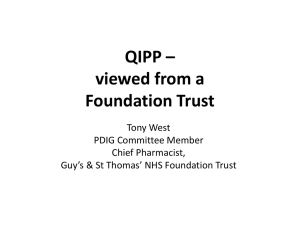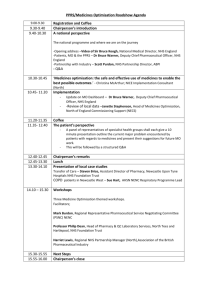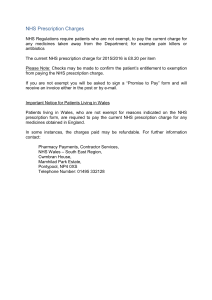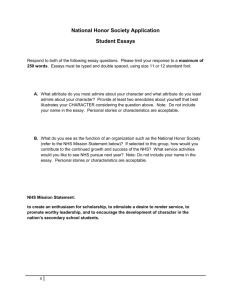iptr - Lothian Joint Formulary
advertisement
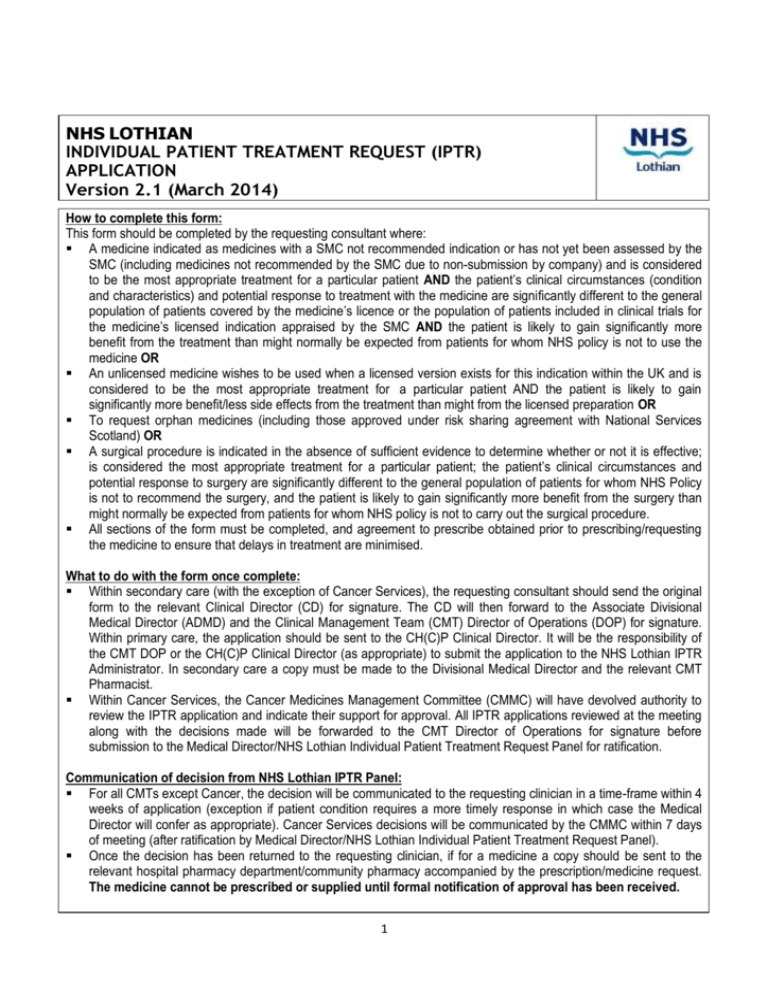
NHS LOTHIAN INDIVIDUAL PATIENT TREATMENT REQUEST (IPTR) APPLICATION Version 2.1 (March 2014) How to complete this form: This form should be completed by the requesting consultant where: A medicine indicated as medicines with a SMC not recommended indication or has not yet been assessed by the SMC (including medicines not recommended by the SMC due to non-submission by company) and is considered to be the most appropriate treatment for a particular patient AND the patient’s clinical circumstances (condition and characteristics) and potential response to treatment with the medicine are significantly different to the general population of patients covered by the medicine’s licence or the population of patients included in clinical trials for the medicine’s licensed indication appraised by the SMC AND the patient is likely to gain significantly more benefit from the treatment than might normally be expected from patients for whom NHS policy is not to use the medicine OR An unlicensed medicine wishes to be used when a licensed version exists for this indication within the UK and is considered to be the most appropriate treatment for a particular patient AND the patient is likely to gain significantly more benefit/less side effects from the treatment than might from the licensed preparation OR To request orphan medicines (including those approved under risk sharing agreement with National Services Scotland) OR A surgical procedure is indicated in the absence of sufficient evidence to determine whether or not it is effective; is considered the most appropriate treatment for a particular patient; the patient’s clinical circumstances and potential response to surgery are significantly different to the general population of patients for whom NHS Policy is not to recommend the surgery, and the patient is likely to gain significantly more benefit from the surgery than might normally be expected from patients for whom NHS policy is not to carry out the surgical procedure. All sections of the form must be completed, and agreement to prescribe obtained prior to prescribing/requesting the medicine to ensure that delays in treatment are minimised. What to do with the form once complete: Within secondary care (with the exception of Cancer Services), the requesting consultant should send the original form to the relevant Clinical Director (CD) for signature. The CD will then forward to the Associate Divisional Medical Director (ADMD) and the Clinical Management Team (CMT) Director of Operations (DOP) for signature. Within primary care, the application should be sent to the CH(C)P Clinical Director. It will be the responsibility of the CMT DOP or the CH(C)P Clinical Director (as appropriate) to submit the application to the NHS Lothian IPTR Administrator. In secondary care a copy must be made to the Divisional Medical Director and the relevant CMT Pharmacist. Within Cancer Services, the Cancer Medicines Management Committee (CMMC) will have devolved authority to review the IPTR application and indicate their support for approval. All IPTR applications reviewed at the meeting along with the decisions made will be forwarded to the CMT Director of Operations for signature before submission to the Medical Director/NHS Lothian Individual Patient Treatment Request Panel for ratification. Communication of decision from NHS Lothian IPTR Panel: For all CMTs except Cancer, the decision will be communicated to the requesting clinician in a time-frame within 4 weeks of application (exception if patient condition requires a more timely response in which case the Medical Director will confer as appropriate). Cancer Services decisions will be communicated by the CMMC within 7 days of meeting (after ratification by Medical Director/NHS Lothian Individual Patient Treatment Request Panel). Once the decision has been returned to the requesting clinician, if for a medicine a copy should be sent to the relevant hospital pharmacy department/community pharmacy accompanied by the prescription/medicine request. The medicine cannot be prescribed or supplied until formal notification of approval has been received. 1 SECTION 1: CONSULTANT, CMT, PATIENT & TREATMENT DETAILS APPLICATION NUMBER (for office use only): Ward or Department: Patient Details: Attach addressograph or use patient CHI number and postcode. CHI Number: Postcode: REH RIE RHSC ROODLANDS RV WGH AA LIBERTON ECC GP Surgery or Other Hospital: Patient’s Health Board: (Please NHS LOTHIAN NHS FIFE NHS BORDERS indicate the Health Board that the patient currently resides) OTHER: Name of Consultant: (print clearly in capitals) Clinical Management Grouping: (please tick) Email: Medicine: REAS/MOE: Critical Care and HSDU Surgery: Radiology, Cancer, H&N: Women’s Children’s & DCN Not applicable since primary care application (please specify CHP,etc below): Medicine name and formulation requested or surgical procedure: Indication: (if surgical procedure please go to clinical rationale for performing after completing this section) Is this a licensed indication for this medicine? NB: If the medicine is a licensed medicine that is being used outwith its marketing authorisation, the prescriber carries the responsibility of the patient’s welfare and may be called to justify his/her actions in the event of an adverse reaction. SMC Guidance (Please tick): Other relevant National Guidance: YES: NO: Accepted by SMC for this indication, but use is non-Formulary Not accepted for use by SMC for this indication New medicine that is awaiting SMC guidance Medicine is recommended in a relevant NICE Single Technology Appraisal : Medicine is recommended in a relevant SIGN Guideline: 2 Clinical rationale for use in this patient, including expected outcome: (For medicines please use Appendix 1 briefing template to assist in preparing this evidence and submit any referenced clinical papers with this form) NHS Lothian policy states that non-Formulary medicines should only be used in exceptional circumstances. Likewise, NHS Lothian policy is that surgical procedures without sufficient evidence of effectiveness should only be undertaken in exceptional circumstances In order to demonstrate exceptionality, the following referral criteria must be met for an IPTR to be considered: The patient’s clinical circumstances (condition and characteristics) and potential response to treatment with the medicine are significantly different to the general population of patients covered by the medicine’s licence or the population of patients included in clinical trials for the medicine’s licensed indication appraised by the SMC and The patient is likely to gain significantly more benefit from the intervention than might normally be expected from patients for whom NHS policy is not to use the medicine/surgery The applicant should clearly document in the space below exactly how this IPTR meets this referral criteria. For example, show that the patient is in a subgroup of the population which was considered and demonstrate using clinical evidence (RCTs, etc.) that this subgroup are likely to respond better. - Appendix 1 gives a detailed template of how to prepare the evidence briefing for medicines to guide the submitting clinician. For surgical procedures, details of the surgical procedure including any papers or peer support for procedure any suspected side effects must be detailed below. Continue on a separate sheet if necessary Previous treatment for this indication: (including duration) Estimated treatment duration (or cycles for oncology medicines); or for surgical procedures the estimated theatre time: Cost Per treatment Cycle: Estimated total cost/ annual cost: Are there any supportive treatments needed for this treatment: Reason Formulary medicine or alternatives to surgery not selected: What will be used if this medicine/ surgery is not used: Planned review: (please state when and how response to treatment will be measured) Where is the treatment to be delivered and does it impact on other areas? (e.g. within acute sector or intended to be continued in primary care) indicate whether the use of this medicine will impact on other directorates or on primary care) Any other information: (if you need to provide any further information in support of your request or need additional space to answer the pervious questions please use this area. Additional Patient Statement (Appendix 2) YES: NO: SIGNATURE OF THE REQUESTING CONSULTANT AND DECLARATION OF INTERESTS: Signature: Date: You are required to declare any current interests you have in the pharmaceutical company who market the medicine you are requesting on this form. Tick one of the four boxes below that best describe the interests you have in the pharmaceutical company who make the requested medicine (e.g. personal and specific). Current interests are those that you have received within the last 12 monhts. If you have no declared interests, please write “NO INTERESTS” in the details box below. PERSONAL INTERESTS Payments/fees/resources etc. that you have received personally from the company NON-PERSONAL INTERESTS Payments/fees/resources etc. that your DETAILS OF INTERESTS: Give details of your interests in this section: SPECIFIC INTERESTS NON-SPECIFIC INTERESTS These are interests relate directly to the medicine you are requesting These are interests that relate to the company, nut not directly to the drug you are requesting SECTION 2: AUTHORISED SIGNATURES PLEASE DO NOT SIGN FORM OFF WITHOUT APPROPRIATE COSTING INFORMATION The CMT Director of Operations or CH(C)P Clinical Director must sign the application before forwarding the to the NHS Lothian IPTR panel for approval before the treatment is prescribed/initiated. CMT Director of Operations or CH(C)P Clinical Director (or nominated deputy) authorisation: Name: (If nominee, please also state position) Signature: Date: For Cancer Services Appendix 3 must be completed by the Cancer Medicine Management Team prior to CMT DOP Signature and submission to the Medical Director/ NHS Lothian IPTR Panel for ratification. Within secondary care only, the following signatures are required before submission to the CMT DOP: Clinical Director’s (or nominated deputy) authorisation: Name: (If nominee, please also state position) Signature: Date: Assistant Divisional Medical Director (or nominated deputy) authorisation: Name: (If nominee, please also state position) Signature: Date: APPENDIX 1 - INDIVIDUAL PATIENT TREATMENT REQUEST (IPTR) EVIDENCE BRIEFING TEMPLATE Previously completed evidence reviews in response to IPTR requests are held in a central repository on the NHS Knowledge Network. Please contact your clinical pharmacist or your local Medicines Information Service on 0131 242 2920 (ext 22920) to check whether a review has previously been conducted for the medicine for the indication in question. The following information should be included in an evidence briefing provided to support the IPTR process. Name of Medicine Licensed Indication Relevant licensed indication as per Summary of Product Characteristics (SPC) in the electronic medicines compendium (eMC) www.medicines.org.uk/emc/ Indication under review A medicine may be licensed for a number of licensed indications which may be subject to differing SMC advice. Some submissions may also be for off-label use of medicines. The exact indication that is the subject of the application should be detailed here. SMC Status www.scottishmedicines.org.uk/smc/CCC_FirstPage.jsp Whether the medicine is “not recommended” or “accepted for use” within specific restrictions should be described. For recently launched medicines where no SMC advice is as yet available, the SMC work programme can provide an estimate of when advice will be available. Other relevant national advice National Institute for Health and Clinical excellence (NICE) www.nice.org.uk/Guidance/TA/Published MTAs Note 1,2 Multiple health technology assessments (MTAs) issued by NICE are reviewed by NHS Quality Improvement Scotland (NHSQiS) who then give advice to NHS Boards about the status of these assessments within Scotland. Where issued, this guidance supersedes any existing SMC advice on the medicine . STAs Note 1,2 The process for NICE Single Technology Assessments (STAs) is broadly similar to that adopted by the SMC and as such STAs decisions have no standing in NHS Scotland. STA advice very rarely comes before or differs from that issued by the SMC but it can be useful to review NICE STAs to establish prescribing policy elsewhere in the UK. Note 2 All Wales Medicines Strategy Group (AWMSG) www.wales.nhs.uk/sites3/page.cfm?orgid=371&pid=24773 Where no SMC or NICE advice exists it may be helpful to identify whether any relevant advice has been issued by this group which has a similar role to the SMC in Scotland. It should be noted that, in Wales, any NICE advice supersedes that issued by AWMSG. SIGN Guidelines www.sign.ac.uk For some medicines, particularly those used in chronic disease management, it may be appropriate to describe any relevant SIGN advice. It should be noted, however, that SIGN do not currently consider cost effectiveness when considering the evidence base for any medicine. Other professional guidelines Note 3 Guidelines issued by relevant clinical or professional bodies that may influence the use of a medicine should be described. Dose and Administration This information should be documented as per eMC for the indication under review. If the medicine is to be used off label, information may be obtained from the pivotal clinical trials. Any information on administration that may impact on service delivery should be described. Background A brief summary of the disease being treated and its usual management may be helpful for the panel, who are not likely to be specialists in the treatment of the disease and medicine under consideration. Summary of evidence of comparative efficacy and adverse effects Where SMC advice has been issued, it may only be necessary to make reference to the Detailed Note 7 Advice Document (DAD). However, where the clinician making the request has made the case that the patient‟s situation is „exceptional‟, it may be necessary to provide a more detailed review of the evidence surrounding this „niche‟ indication. Where no SMC, NICE or AWMSG advice is available a detailed independent review of the literature may be required. Clinical Effectiveness This section should include a comment on any relevant issues in relation to how the clinical efficacy data may translate into clinical practice. For example, the patient population within the trials may differ significantly from that encountered locally. In addition, any wider policy issues in relation to how the medicine has been used elsewhere may be important. A comment on potential success criteria, monitoring and stopping rules should be considered. Health Economics Where SMC advice has been issued, relevant information from the Detailed Advice Document (DAD) Note 7 should be detailed. In some boards, specialist advice from health economists may be available. Where no SMC advice is available (or where the medicine is to be used in a different patient group than that reviewed by SMC) and specialist input is also unavailable, any relevant published health Note 4 economic data may be described. Cost The NHS cost of the medicine should be included. This should be the cost for one year. Note 5 The cost of any consumables or sundries should also be considered where relevant References The main references used in the preparation of the briefing should be included. Search Strategy It is good practice to document the search strategy undertaken when preparing the briefing. Note 6 Author’s details The name of the author, checker and the date written should be included in the document Notes 1. 2. 3. The first page of NICE technology assessments published in the last 2-3 years should state on the front page whether they are STAs or MTAs. E.g. “This guidance was developed using the single technology appraisal process.” However, this may not always be clear. The status of these TAs for NHS Scotland can be confirmed on NHS Healthcare Improvement Scotland (HIS) website www.healthcareimprovementscotland.org/programmes/nice_guidance_and_scotland.aspx The National Electronic Library for Medicines www.nelm.nhs.uk/en/ routinely publishes advice issued by SMC, NICE and AWMSG and may, therefore, be a quick link to these websites There is no comprehensive method of searching for these guidelines. Some may be archived within the NeLM website. Others may be picked up from general review articles on the topic. In some cases it may be necessary to search the website of any relevant professional bodies. 4. 5. 6. 7. In some cases NICE may have carried out health economic reviews of patient subgroups within the trials that may have relevance to the application. Rarely, relevant heath economics studies may be published in the medical literature (identifiable via a Embase® or Medline® search or from the Cochrane Library) For a medicine that is expected to be continued in Primary Care, the basic NHS cost as per the BNF or MIMS should be used. For medicines to be prescribed in acute care only, the NHS hospital cost should be used. It may be agreed locally that the search strategy is not included in the published briefing but is held in the archived copy for information. The Detailed Advice Document is published by the Scottish Medicines Consortium for each of the medicines considered by its committees. It includes details of the medicine and indication reviewed, the advice to NHS boards and a clinical appraisal of the clinical and economic data submitted by the pharmaceutical company. It includes sections on: indications, dosing information, product availability date, comparative efficacy, comparative safety, clinical effectiveness, comparative health economics, relevant guidelines, previous SMC advice, comparative costs and budget impact. APPENDIX 2: PATIENT (O R PATIE NT’S RE PRE SENTATIVE) STATEMENT The patient (or their representative) should use this space to comment on this treatment request: (Continue on a separate sheet if necessary) Continue on a separate sheet if necessary Name: Signature: Date:

